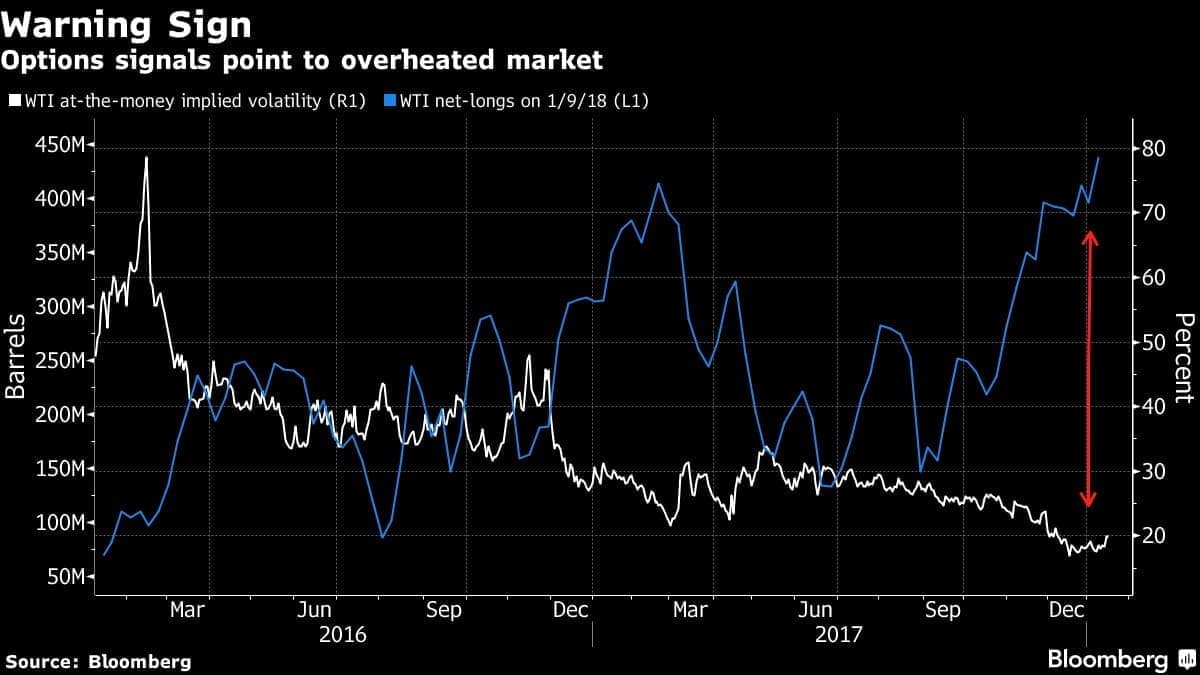Friday January 19, 2018
In the latest edition of the Numbers Report, we’ll take a look at some of the most interesting figures put out this week in the energy sector. Each week we’ll dig into some data and provide a bit of explanation on what drives the numbers.
Let’s take a look.
1. Venezuela’s oil production plunges
(Click to enlarge)
- OPEC reports monthly production figures in two ways, one from secondary (independent) sources, and also using data reported to them from member governments. Venezuela has typically overstated its production relative to the secondary sources, likely in order to downplay the crisis it faces.
- But in the latest report, Venezuela itself said that its production plunged by 216,000 bpd in December, a massive decline, taking output down to 1.621 mb/d, its lowest level in decades. The secondary sources reported a more modest, but still severe, decline of 82,000 bpd.
- If the government data is accurate, it points to a deeper, more serious decline underway than most market analysts thought. Venezuela lost 649,000 bpd in 2017, a decline of about 29 percent.
- The losses are surely set to continue. Francisco Monaldi of Rice University says that output could fall to 1.3 mb/d this year.
2. China’s aggressive clean energy spending
(Click to enlarge)
- China spent $33 billion on clean energy last year, an increase of nearly 25 percent from a year earlier.
- China continues to lead…
Friday January 19, 2018
In the latest edition of the Numbers Report, we’ll take a look at some of the most interesting figures put out this week in the energy sector. Each week we’ll dig into some data and provide a bit of explanation on what drives the numbers.
Let’s take a look.
1. Venezuela’s oil production plunges

(Click to enlarge)
- OPEC reports monthly production figures in two ways, one from secondary (independent) sources, and also using data reported to them from member governments. Venezuela has typically overstated its production relative to the secondary sources, likely in order to downplay the crisis it faces.
- But in the latest report, Venezuela itself said that its production plunged by 216,000 bpd in December, a massive decline, taking output down to 1.621 mb/d, its lowest level in decades. The secondary sources reported a more modest, but still severe, decline of 82,000 bpd.
- If the government data is accurate, it points to a deeper, more serious decline underway than most market analysts thought. Venezuela lost 649,000 bpd in 2017, a decline of about 29 percent.
- The losses are surely set to continue. Francisco Monaldi of Rice University says that output could fall to 1.3 mb/d this year.
2. China’s aggressive clean energy spending

(Click to enlarge)
- China spent $33 billion on clean energy last year, an increase of nearly 25 percent from a year earlier.
- China continues to lead on clean energy. In 2018, Bloomberg New Energy Finance predicts that global solar installations will hit 107 GW, with China capturing 47-65 GW. The country installed 53 GW of new solar last year.
- However, BNEF also notes that some of that spending was “fundamentally irrational,” because some of the subsidies for developers are not clearly going to be delivered.
- Nevertheless, China will continue to dominate in solar, wind and EV sales. BNEF sees 1.5 million EVs sold this year, with China making up more than half of that.
3. Oil market overheating?

(Click to enlarge)
- Bloomberg reports that some technical signs point to overheating in the oil market.
- The so-called “gamma-theta” indicator, which shows price moves traders expect to see each day, has plunged.
- This suggests that a wave of financial inflows into the market, rather than oil fundamentals, are responsible for price increases.
- “Volatility compression combined with record-breaking positioning offers an important clue into the market’s setup,” Thibaut Remoundos, founder of London-based Commodities Trading Corporation, told Bloomberg. “Oil markets are now flow-driven by macro-rotation to the sector, getting disconnected from fundamentals, and that tends to end badly.”
- In plain English, speculators could be pushing oil higher than is justified by the fundamentals.
4. Peak oil demand is coming, but when?

(Click to enlarge)
- Peak oil demand has become a hot debate topic, but the exact date at which the world hits the peak is not interesting or important, a new report coauthored by BP’s (NYSE: BP) chief economist says. Forecasting is too uncertain, as is clearly indicated in the chart above, which offers various peak demand scenarios.
- But BP does see the peak coming, and there are huge ramifications for that. The market will shift from “an age of (perceived) scarcity to an age of abundance.”
- In this new era, slowing demand growth combined with abundant supply will make markets more competitive. Oil producers could rush to produce as much as possible to monetize their assets while they have the chance.
- That could push prices lower. That will put the stability of fragile oil-producing nations to the test, and the report argues they will struggle with persistent fiscal deficits.
- In short, peak demand is coming, and the exact date doesn’t particularly matter. The direction matters – peak demand means investors will balk at ploughing money into a declining industry, producers will try to maximize output, and prices will probably head lower.
5. Oil and gas employment on the rise, poses risks

(Click to enlarge)
- After savage cuts to U.S. oil and gas employment from 2014 through 2016, hiring is picking up as drilling expands.
- As of November, there were an estimated 413,000 people working in oil and gas in the U.S., down from over 530,000 in late 2014, but significantly up from 370,000 in late 2016.
- The hiring shows an industry on the rebound, but it also means that some areas are having difficulty finding enough workers. Unemployment rates in several West Texas counties – where Permian drilling is going full-tilt – have dropped below 3 percent.
- The drilled but uncompleted wells (DUC) backlog skyrocketed last year. At the end of 2017, the DUC list nearly hit 7,500, up from 5,674 at the start of the year. Some of the reason for the growing backlog was a shortage of fracking crews.
- Labor market tightness could put upward pressure on costs for shale drillers, offsetting some of the gains from higher oil prices.
6. OPEC worries about U.S. shale

(Click to enlarge)
- OPEC’s cuts are working, perhaps too well. Inventories continue to decline and oil prices have surged to multi-year highs.
- But there are some growing concerns that the cuts are ceding too much market share to U.S. shale. OPEC noted in its latest Oil Market Report that it thinks U.S. output will rise by more than it thought.
- “Higher oil prices are bringing more supply to the market, particularly in North America and specifically tight oil,” OPEC wrote.
- Notably, the group revised up its forecast for U.S. output to 1.15 mb/d, a sharp increase of 160,000 bpd from last months’ report.
- The group will gather in the next few days for a routine monitoring meeting, but one of the hot topics will be assessing the status of the market to see if the cuts are tightening things too much.
7. China’s oil output slides

(Click to enlarge)
- Amid stories of outages in Libya, Nigeria and Venezuela, the declines in production in China are often overlooked. But China has suffered steep losses since 2015, and the declines will extend into a third year in 2018.
- China’s oil fields are aging and costly to maintain. The drop in oil prices forced some austerity measures at the country’s national oil companies. They slashed spending and shutdown old wells that no longer made money.
- Meanwhile, the state-owned companies are focusing on trying to boost natural gas output.
- “We believe a combination of the recent slowdown in investment in new oil plays, maturing onshore reserves and continuing investment shift toward natural gas will drag on domestic oil output,” said Peter Lee, an analyst BMI Research, according to Bloomberg.
- Oil output in China fell by 4 percent in 2017, or a loss of more than 150,000 bpd.
- That comes even as Chinese oil demand continues to rise, albeit at a slower rate than in the past.
- Taken together, China’s falling production and rising consumption makes it a significant bullish force on oil prices.
That’s it for this week’s Numbers Report. Thanks for reading, and we’ll see you next week.





















